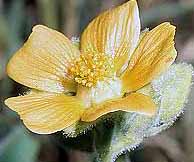|
|
|
|
|
|
|
Name:
Latin name: Abutilon theophrasti
Common name: China jute
Family:
Malvaceae
Author:
Medik.Botanical references
Range:
Asia - tropical. Naturalised in S.E.
Europe and the Mediterranean
Cultivated ground and waste places.
Soil:
The plant prefers light (sandy), medium (loamy) and heavy (clay) soils and requires well-drained soil. The plant prefers acid, neutral and basic (alkaline)
soils and can grow in very alkaline soil. It can grow in semi-shade (light woodland) or no shade. It requires dry or moist soil.
Climate:
The plant requires full sun or part day shade and a fertile well-drained
soil . Tolerates a pH in the range 5 to 8.2. This species is cultivated for its fibre in China and Russia where it succeeds as far north as latitude 56°n in
W. Siberia. It is hardier and more disease- resistant than Jute (Corchorus
spp.). Introduced to N. America in the eighteenth century, it has become a pestilential weed in many parts of the
country. |

China Jute

China jute flower |
Physical Characteristics:
A annual that grows to 1.0 meters (3.3 feet) high by 0.5 meters
(1.65 feet) wide. This plant tolerates alkaline ph and has hermaphrodite flowers and is hardy to
zone 4. It is in leaf from May to October, in flower from July to August. The flowers are hermaphrodite (have both
male and female organs).
Cultivation:
Seed - sow early April in a greenhouse. Germination should
take place within 2 - 3 weeks. When large enough to handle, prick the seedlings
out into individual pots and plant them out in May or June, after the last expected frosts.
An outdoor sowing in April to early May in situ could also be tried, especially in those areas with warm summers.
Known Hazards:
No hazards are known
Uses:
It is used in fibre, oil, paper, astringent, demulcent, diuretic, emollient, laxative,
ophthalmic, poultice, stomachic, fruit, seed.
Edible Uses:
Seeds - raw or cooked. They can be eaten raw when they are
under-ripe. The ripe seed is dried and ground into a powder then used in soups, bread
etc. It is washed first to remove any bitterness. The seed contains about 17.4% protein, 16% fat, 33.8% carbohydrate, 4.4%
ash. Unripe fruit - raw. This is really more of a seedpod [K].
Medicinal Uses:
Ophthalmic. Used in the treatment of dysentery and opacity of
the cornea. The leaves contain 0.01% rutin and are used as a demulcent. A tea made from the dried leaves is used in the treatment of
dysentery and fevers. A poultice of the leaves is applied to ulcers.
The bark is astringent and diuretic. A tea made from the dried root is used
in the treatment of dysentery and urinary incontinence. It is also used to treat
fevers . The seed is powdered and eaten in the treatment of dysentery, stomach-aches
etc. It is demulcent, diuretic, emollient, laxative and stomachic.
Other Uses:
A fibre obtained from the stems is used as a jute
substitute. It is coarse but flexible and strong. It is also used in rope-
making]. It takes dyes well. The fibre is also used for making paper, the stems are harvested in the summer, the leaves removed and the stems
steamed in order to remove the fibres[189]. The seeds contain about 19% of a
semi-drying oil .
References:
PIW : Website
Uphof. J. C. Th. Dictionary of Economic Plants. An excellent and very comprehensive guide but it only gives very short
descriptions of the uses without any details.
A Dictionary of Plants Used by Man. by Usher. G.: Lists a very extensive range of useful plants from around the world
with very brief details of the uses.
Encyclopaedia Britannica. 15th edition. It contains a few
things of interest to the plant project.
Forest Flora of Srinagar. by Singh. Dr. G. and Kachroo. Prof. Dr. P.
(Bishen Singh Mahendra Pal Singh) A good flora of the western Himalayas and information on plant uses.
A Weavers Garden. by Buchanan. R : Covers all aspects of growing
your own clothes, from fibre plants to dyes.
Economic Botany. by Hill. A. F. : Not very
comprehensive, but it is quite readable and goes into some a bit of detail about
the plants
Plants for Human Consumption. by Kunkel. G. : An excellent book for the dedicated. A comprehensive listing of
latin names with a brief list of edible parts.
Chinese Materia Medica. by Stuart. Rev. G. A.: A translation of an ancient Chinese herbal. Fascinating.
Famine Foods of the Chiu-Huang Pen-ts'ao. by Reid. B. E.: A translation of an ancient Chinese book on edible
wild foods.
Plant Fibres for Papermaking. by Bell. L. A. : A good practical section on how to make paper on a small scale plus details of
about 75 species
The New RHS Dictionary of Gardening. by Huxley. A.: A very comprehensive,
readable book..
The History and Folklore of North American Wild Flowers. by Coffey. T.
A lots of information on
plant uses.
Medicinal Plants of China by Duke. J. A. and Ayensu. E. S.: Details of over 1,200 medicinal plants of China and brief details of their uses.
A Field Guide to Medicinal Plants. Eastern and Central N. America. by
Foster. S. & Duke. J. A. :A concise
book dealing with almost 500 species. A line drawing of each plant is included
plus colour photographs of about 100 species.
Glossary of Indian Medicinal Plants (Including the Supplement). by Chopra.
R. N., Nayar. S. L. and Chopra. I. C. (Council of Scientific and Industrial Research, New
Delhi):
Very terse details of medicinal uses of plants with a wide range of references and details of research into the plants chemistry.
|
|

